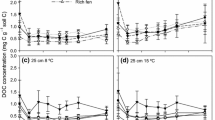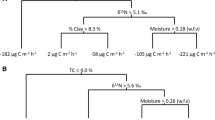Abstract
Current models predict more intense rainstorms and extreme drought events in response to global climate change. In wetlands, greater variation in precipitation may increase fluctuation in wetland size, expanding the area of soil exposed to drying/rewetting cycles and periodic inundation. We investigated the potential impact of these changes on rates of methane (CH4) production from wetland soils along a moisture gradient encompassing open water through a zone of seasonal saturation to dry prairie. We used short (2 day) and long term (7 week) anoxic incubations of soils collected along our gradients to assess how soils exposed to varying levels of saturation would respond to drying/rewetting cycles and inundation. In both incubations, permanently-saturated soils showed the highest initial CH4 production potential. Seasonally-saturated (ephemeral) soils, however, generally produced more CH4 after short term drying and rewetting and after several weeks of anoxic incubation. Observed temporal delays in the onset of rapid CH4 production ranged from 5 to 30 days and were longer in ephemeral than in permanently wet soils. In addition, ephemeral soils showed larger increases in rates of CH4 production following temporal delays, suggesting increased CH4 production as wetlands become more hydrologically dynamic.




Similar content being viewed by others
References
Achtnich C, Bak F, Conrad R (1995) Competition for electron donors among nitrate reducers, ferric iron reducers, sulfate reducers, and methanogens in anoxic paddy soil. Biology and Fertility of Soils 19:65–72
Aller RC (1994) Bioturbation and remineralization of sedimentary organic matter: effects of redox oscillation. Chemical Geology 114:331–345
Angel R, Claus P, Conrad R (2012) Methanogenic archaea are globally ubiquitous in aerated soils and become active under wet anoxic conditions. ISME Journal 6:847–862
Blodau C, Moore T (2003) Micro-scale CO2 and CH4 dynamics in a peat soil during a water fluctuation and sulfate pulse. Soil Biology and Biochemistry 35:535–547
Bloom AA, Palmer PI, Fraser A, Reay DS (2012) Seasonal variability of tropical wetland CH4 emissions: the role of the methanogen-available carbon pool. Biogeosciences 9:2821–2830
Boon PI, Mitchell A, Lee K (1997) Effects of wetting and drying on methane emissions from ephemeral floodplain wetlands in south-eastern Australia. Hydrobiologia 357:73–87
Bousquet P, Ciais P, Miller JB et al (2006) Contribution of anthropogenic and natural sources to atmospheric methane variability. Nature 443:439–443
Chow GC (1960) Tests of equality between sets of coefficients in two linear regressions. Econometrica 28(3):591–605
Denef K, Six J, Paustian K, Merckx R (2001) Importance of macroaggregate dynamics in controlling soil carbon stabilization: short-term effects of physical disturbance induced by dry–wet cycles. Soil Biology and Biochemistry 33:2145–2153
Estop-Aragonés C, Knorr K-H, Blodau C (2013) Belowground in situ redox dynamics and methanogenesis recovery in a degraded fen during dry-wet cycles and flooding. Biogeosciences 10:421–436
Evans SE, Wallenstein MD (2012) Soil microbial community response to drying and rewetting stress: does historical precipitation regime matter? Biogeochemistry 109:101–116
Fang L, Cong-Qiang L, Shi-lu W, Zheng-jie Z (2012) Soil temperature and moisture controls on surface fluxes and profile concentrations of greenhouse gases in karst area in central part of Guizhou Province, southwest China. Environmental Earth Sciences 67:1431–1439
Fenner N, Freeman C (2011) Drought-induced carbon loss in peatlands. Nature Geoscience 4:895–900
Fierer N, Schimel JP (2003) A proposed mechanism for the pulse in carbon dioxide production. Soil Science Society of America Journal 67:798–805
Freeman C, Ostle N, Kang H (2001) An enzymic ‘latch’ on a global carbon store. Nature 409:149
Halverson LJ, Jones TM, Firestone MK (2000) Release of intracellular solutes by four soil bacteria exposed to dilution stress. Soil Science Society of America Journal 64:1102–1109
Hershey AE, Northington RM, Whalen SC (2014) Substrate limitation of sediment methane flux, methane oxidation and use of stable isotopes for assessing methanogenesis pathways in a small arctic lake. Biogeochemistry 117:325–336
Holmes RM, Aminot A, Kérouel R et al (1999) A simple and precise method for measuring ammonium in marine and freshwater ecosystems. Canadian Journal of Fisheries and Aquatic Sciences 56:1801–1808
Huntington TG (2006) Evidence for intensification of the global water cycle: review and synthesis. Journal of Hydrology 319:83–95
IPCC Climate Change 2013: Impacts, adaptation, and vulnerability. Cambridge University Press
Jerman V, Metje M, Mandi I (2009) Wetland restoration and methanogenesis : the activity of microbial populations and competition for substrates at different temperatures. Biogeosciences 6:1127–1138
Kieft TL, Soroker E, Firestone MK (1987) Microbial biomass response to a rapid increase in water potential when dry soil is wetted. Soil Biology and Biochemistry 19:119–126
Le Mer J, Roger P (2001) Production, oxidation, emission and consumption of methane by soils : a review. European Journal of Soil Biology 37:25–50
Lu Y, Conrad R (2005) In situ stable isotope probing of methanogenic archaea in the rice rhizosphere. Science 309:1088–1090
Megonigal JP, Hines ME (2004) Anaerobic metabolism : linkages to trace gases and aerobic processes. In: Schlesinger WH (ed) Biogeochemistry, 2nd edn. Elsevier-pergamon, Oxford, pp 317–424
Mitchell AM, Baldwin DS (1999) The effects of sediment desiccation on the potential for nitrification, denitrification, and methanogenesis in an Australian reservoir. Hydrobiologia 392:3–11
Real R, Kluber HD, Conrad R (1997) Early initiation of methane production in anoxic rice soil despite the presence of oxidants. FEMS Microbiology Ecology 24:311–320
Shindell DT, Walter BP, Faluvegi G (2004) Impacts of climate change on methane emissions from wetlands. Geophysical Research Letters 31, L21202
Ström L, Tagesson T, Mastepanov M, Christensen TR (2012) Presence of Eriophorum scheuchzeri enhances substrate availability and methane emission in an Arctic wetland. Soil Biology and Biochemistry 45:61–70
Stumm W, Morgan JJ (1996) Aquatic chemistry: chemical equilibria and rates in natural waters, 3rd edn. Wiley Interscience, New York
Sun Z, Wang L, Tian H et al (2013) Chemosphere fluxes of nitrous oxide and methane in different coastal Suaeda salsa marshes of the Yellow River estuary, China. Chemosphere 90:856–865
Todd CED, Harbor JM, Tyner B (2006) Increasing magnitudes and frequencies of extreme precipitation events used for hydraulic analysis in the Midwest. Journal of Soil and Water Conservation 61:179–184
Turetsky MR, Treat CC, Waldrop MP, et al. (2008) Short-term response of methane fluxes and methanogen activity to water table and soil warming manipulations in an Alaskan peatland. Journal of Geophysical Research 113:1–15
Utomo WH, Dexter AR (1982) Changes in soil aggregate water stability induced by wetting and drying cycles in non-saturated soil. Journal of Soil Science 33:623–637
Van Gestel M, Merckx R, Vlassak K (1993) Microbial biomass responses to soil drying and rewetting: The fate of fast and slow-growing microorganisms in soils from different climates. Soil Biology and Biochemistry 25:109–123
Vance ED, Brookes PC, Jenkinson DS (1987) An extraction method for measuring soil microbial biomass C. Soil Biology and Biochemistry 19:703–707
Von Fischer JC, Rhew RC, Ames GM et al (2010) Vegetation height and other controls of spatial variability in methane emissions from the Arctic coastal tundra at Barrow, Alaska. Journal of Geophysical Research 115:1–11
Weijers JWH, Schouten S, van der Linden M et al (2004) Water table related variations in the abundance of intact archaeal membrane lipids in a Swedish peat bog. FEMS Microbiology Letters 239:51–56
Wetherald RT, Manabe S (2002) Simulation of hydrologic changes associated with global warming. Journal of Geophysical Research 107:4379
Zeileis A, Leisch F, Hornik K, Kleiber C (2002) Strucchange: an R package for testing for structural change in linear regression models. Journal of Statistical Software 7(2):1–38
Acknowledgments
Funding for this research was provided by the Margaret A. Cargill foundation, St. Olaf College, and NSF DBI-1004817. Thanks go to Dr. Jean Porterfield, Dr. Stephanie Schmidt, Laurel Lynch, Ellen Daugherty, Katie Halvorson, Karl Lapo, Kateri Salk, Laura Nelson, and Holly Rich for discussion of ideas, and assistance in field and laboratory.
Author information
Authors and Affiliations
Corresponding author
Electronic supplementary material
Below is the link to the electronic supplementary material.
Supplementary Fig. S1
Examples of CH4 concentration time series data for COE and Bakko wetlands. Error bars indicate±1 standard error. (DOCX 70 kb)
Rights and permissions
About this article
Cite this article
Kannenberg, S.A., Dunn, S.T., Ludwig, S.M. et al. Patterns of Potential Methanogenesis Along Soil Moisture Gradients Following Drying and Rewetting in Midwestern Prairie Pothole Wetlands. Wetlands 35, 633–640 (2015). https://doi.org/10.1007/s13157-015-0653-3
Received:
Accepted:
Published:
Issue Date:
DOI: https://doi.org/10.1007/s13157-015-0653-3




